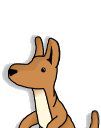

'Bring on the Maths' is an incredibly flexible resource that can be used to assess learning and inform future planning and teaching. The key to its success is that it provides great opportunities for pupils to play a more active role in their learning through interactive discussion and the exposing of mistakes and misconceptions. While all of the 898 available activities are based on the same 12-cell structure, there are five basic design-types used. A pdf version of this page can be found here, and more information on each of the design-types is provided below:
Find another | Find a friend | Find the logic | Find the group | Find the orderFind another
The original design-type for 'Bring on the Maths', and by far the most common, these activities provide a problem with twelve possible solutions. Clicking on a correct answer reveals a letter, and clicking on an incorrect answer reveals a cross. When all the correct answers have been located, the letters can be rearranged to find a key mathematical word connected to the topic in question. Some activities (especially in the Key Stage 3 package) inform learners of the number of correct solutions they are seeking, but the majority keep this fact hidden.
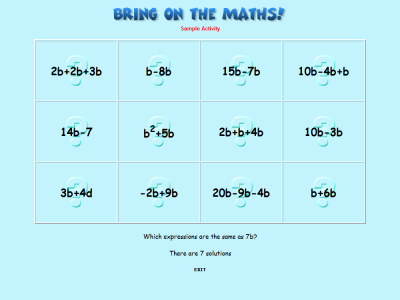

Learners can work individually or in small groups to try and find all the solutions to the problem in an allotted time, say 5 minutes. When the time is up the teacher asks for volunteers for one answer at a time - No answer should be accepted without a correct justifcation - guessing is not allowed!! When all the letters have been revealed, the challenge is to rearrange them into a key mathematical word (or occasionally a ‘mystery mathematician’) linked to the topic.
Alternatively, learners can work in groups to try and find all the solutions. The teacher picks a group to start offering solutions - again, answers should be justified. Points for correct answers can be awarded if the activity is being used as a competition. The group continues until an incorrect answer is given (i.e. a cross appears!) or until they have exhausted their collection of answers. Either way, the next group picks up the challenge to try and solve the problem (a group has to offer at least one solution before being allowed to pass). The group who finds the last letter has the first opportunity to solve the anagram to reveal the key word - a time limit of 15 seconds to solve the anagram is sensible! If they cannot solve the anagram, it is passed on to the next group and so on.
The pdf version of each activity might be used for learners to write on. They could be asked to mark each cell with either a tick or cross. When they are done the teacher informs them how many (out of 12) are correctly labelled but, crucially, not which ones are correctly labelled. If they do not have 12 out of 12 they enter a problem-solving exercise to work out which cells need altering, and why. As the activity draws to a close the teacher can put the interactive version up at the front of the classroom, run through justified answers and still finish with the anagram puzzle.
The real beauty of the 'find another' version is that learners are made to question why an answer is wrong. This really identifies the common mistakes and misconceptions that are built into 'Bring on the Maths' activities, and the teacher can build on this in future teaching. Even if none of the incorrect solutions are uncovered, it is worth asking learners to consider why the incorrect answers have been chosen.
Sample activities of the 'find another' type are:
- Level 5: Calculating: order of operations
- Year 7: Simplifying expressions
- Year 7: Finding angles
- Year 7: Comparing statistics
- Year 8: Fractions, decimals and percentages
- Year 8: Calculating areas
- Year 8: Graphs and charts
- Year 9: Proportion
- Year 9: Transformations
- Year 9: Logic: Pythagoras
- KS3 Top-up: Place value
- Higher Number: Standard form
- Higher Algebra: Completing the square
- Higher Shape: Combining transformations
- Higher Data: Frequency density
- Foundation Top-up: Working with angles
- Core 1: Coordinate Geometry
- Core 1: Recurrence relations
- Core 2: Factor Theroem
- Core 3: Range and Domain
- Core 4: Binomial Expansion
- Core 4: Vectors
Find a friend
These ‘Bring on the Maths’ activities provide a problem which requires learners to find matching pairs or triples. The pairs (or triples) are indicated by the colour of the letter that appears when the cell is clicked on. Any cell that does not have a matching pair (or triple) is indicated by a cross. As before, when all the correct answers have been located, the letters can be rearranged to find a key mathematical word connected to the topic in question.
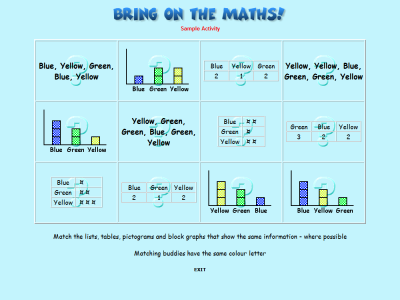
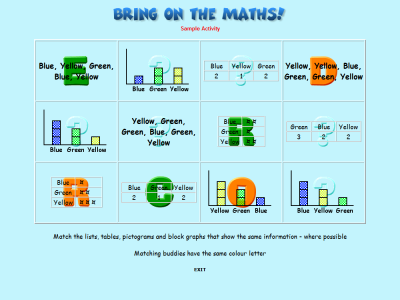
Learners can work in similar ways as mentioned in the previous section, and again it is important that answers are justified. The cells that do not match any other (i.e. those indicated by a cross) may well be chosen since they are designed to match if a common mistake or misconception is applied. Also, such mistakes and misconceptions may well lead to learners attempting to match cells that are each part of a different pair (or triple) as this had been built in as part of the design process.
The pdf version of the activities can be used to create a card set if you wish learners to manipulate the situation ‘on the desk’.
Sample activities of the 'find a friend' type are:
- Level 2: Handling Data: Recording results
- Level 8: Algebra: Deriving formulae
- Higher Number: Subtracting fractions
- Higher Algebra: Inequalities
- Higher Data: Stem-and-leaf diagrams
- Foundation Top-up: Constructing bar charts
- Core 1: Differentiation
- Core 2: Trigonometrical graphs
- Core 2: Integration
- Core 3: Logarithmic equations
- Core 4: Integration and volumes
Find the logic
These activities provide a larger problem which requires the cells to be placed in a correct logical order to form a full solution; for example, to use the provided statements and diagrams to produce a proof of the alternate segment theorem. Instead of letters, numbers will appear when the cells are clicked on so as to indicate the correct order, and consequently there is no key word in these cases. Some of the activities require all twelve cells, but most will contain incorrect statements that do not fit in to the logical solution, and again, these are based on common errors and misconceptions. There are also some activities that require two or three shorter sets of ordered cards; for example, to produce solutions for a set of equations. In these cases, the colour of the numbers revealed indicates the group to which they belong.
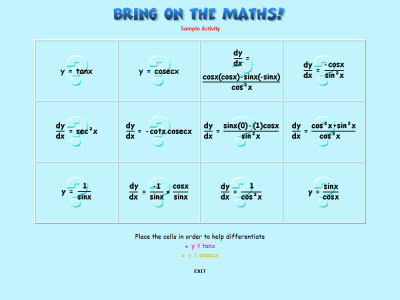
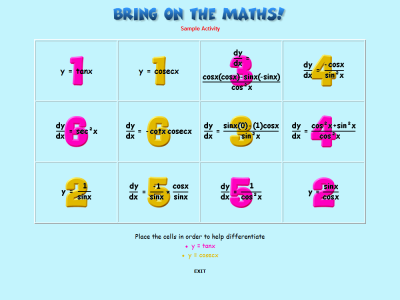
These activities in particular lend themselves to having accompanying card sets made from the pdf version. Many learners will prefer to manipulate the situation ‘on the desk’ while they are thinking through the process. In some cases, learners should be encouraged to look for correct use of punctuation as an added hint that might help them find the required order.
It is important to note that the problems usually ask learners to ‘place the cells in a correct logical order ...’ (rather than ‘the logical order’). Although unlikely, it may be the case that they can find an alternative solution. If so, it is essential that they justify their reasoning and are still able to engage in the idea of ‘someone else’s mathematics’ being equally valid.
Sample activities of the 'find the logic' type are:
- KS3 Top-up: Solving equations
- Higher Number: Direct proportion
- Higher Algebra: Trial and improvement
- Higher Shape: Alternate segment theorem
- Core 3: Trigonometrical differentiation
Find the group
A small number of ‘Bring on the Maths’ activities require learners to categorise the cells into more than two groups; for example, ‘always true’, ‘sometimes true’ and ‘never true’, or as in the second sample activity, into ‘sine’, ‘cosine’, ‘tangent’ and ‘different’. In these cases, the letter revealed will indicate the appropriate group and as such there is no key word.
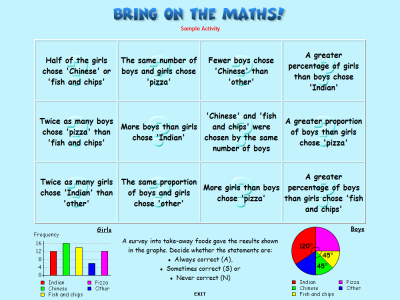
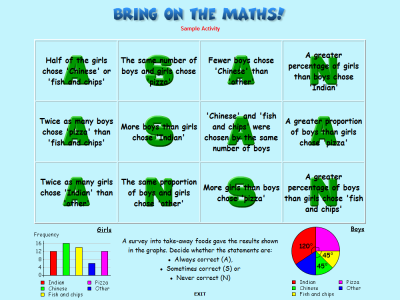
This is another design-type for which card sets made from the pdf version may prove to be a valuable addition to the interactive version at the front of the classroom.
Sample activities of the 'find the group' type are:
- KS3 Top-up: Making comparisons
- Higher Shape: Trigonometric ratios
Find the order
Probably the least common design-type, these ‘Bring on the Maths’ activities ask learners to place the cells in order - usually the order of size of the solution - but in the case of the moving average example below, a specific order that makes sense in the context of the question. As in the 'find the logic' activities, numbers will appear when the cells are clicked on so as to indicate the correct order, and consequently there is no key word in these cases.

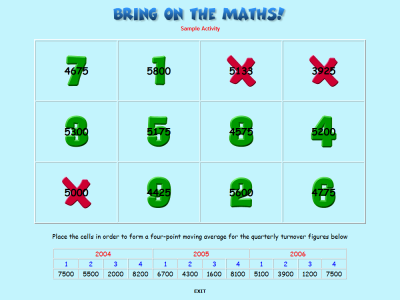
Again, card sets made from the pdf version of these activities may prove to be a valuable addition to the interactive version at the front of the classroom.
Sample activities of the 'find the order' type are:
- Higher Data: Moving averages
- Foundation Top-up: Finding percentages of amounts